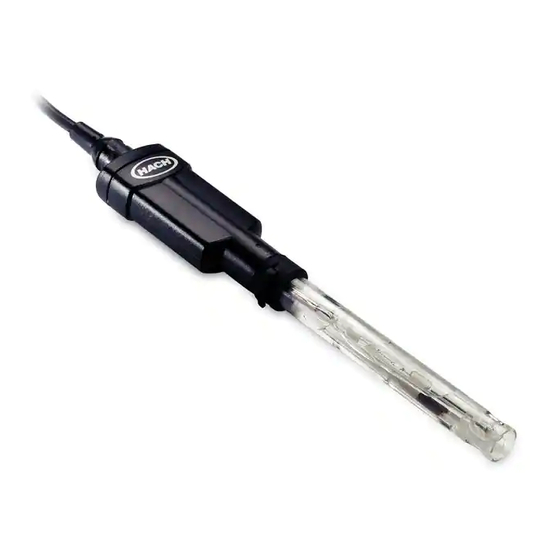
Table of Contents
Advertisement
Quick Links
Advertisement
Table of Contents

Summary of Contents for Hach PHC281
- Page 1 DOC022.53.80024 PHC281 05/2021, Edition 3 User Manual...
-
Page 3: Table Of Contents
Table of Contents Section 1 Product overview ................. 3 Section 2 Specifications ..................3 Section 3 Safety information ................4 3.1 Intended use ....................... 4 3.2 Use of hazard information ..................4 3.3 Precautionary labels ..................... 5 3.4 Product hazards ....................5 Section 4 Preparation for use ................ - Page 4 Table of Contents...
-
Page 5: Section 1 Product Overview
Section 1 Product overview The Intellical PHC281 series pH probes are digital, combination electrodes that measure the pH of water samples. The probes are refillable and have a built-in temperature sensor. The probes have good performance in low ionic strength (LIS) samples (e.g., deionized, reverse osmosis, distilled) and other clean waters (specific conductance less than 100 µS/cm to ultrapure). -
Page 6: Section 3 Safety Information
Specifications Details Temperature accuracy ±0.3 °C (±0.54 °F) Temperature sensor type 30 kΩ NTC thermistor Operating temperature 0 to 50 °C (32 to 122 °F) Storage temperature 5 to 40 °C (41 to 104 °F) Minimum immersion depth 15 mm (0.59 in.) ™... -
Page 7: Precautionary Labels
3.3 Precautionary labels Read all labels and tags attached to the instrument. Personal injury or damage to the instrument could occur if not observed. A symbol on the instrument is referenced in the manual with a precautionary statement. Electrical equipment marked with this symbol may not be disposed of in European domestic or public disposal systems. - Page 8 Figure 2 Remove the protective tape 6 English...
-
Page 9: Section 5 Calibration
Figure 3 Probe position during use 1 Open filling hole 3 Level of calibration solution or sample 2 Level of electrolyte filling solution Section 5 Calibration The procedure that follows is applicable to meters that can connect to Intellical pH probes. Refer to the applicable meter documentation for meter operation and probe-specific settings. -
Page 10: Calibration Procedure
5.2 Calibration procedure 1. Go to the 2. Prepare or pour 3. Open the filling 4. Rinse the probe calibrate menu. the pH buffer hole. with deionized water. Select the probe, if solutions in different Dry the probe with a applicable. -
Page 11: Section 6 Sample Measurement
Section 6 Sample measurement The procedure that follows is applicable to meters that can connect to Intellical pH probes. Refer to the applicable meter documentation for meter operation and probe-specific settings. 6.1 Sample measurement notes Read the notes that follow before sample measurements. •... -
Page 12: Section 7 Verify The Calibration
Section 7 Verify the calibration Measure the pH value of a fresh pH buffer solution to make sure the result is accurate. The meter compares the selected pH buffer value to the measured pH value and accepts or rejects the measurement. -
Page 13: Section 8 Maintenance
Section 8 Maintenance Regular maintenance is necessary for the best accuracy, stabilization time and life of the probe. Keep the probe in the recommended storage solution between measurements. 8.1 Clean the probe N O T I C E Probes with an open reference junction can become permanently damaged if the reference junction is soaked for a long time in a cleaning solution. -
Page 14: Fill The Probe
Table 1 Cleaning solution Contamination Cleaning solution Active component Soak time ™ General Electrode cleaning solution for KATHON 12–16 hours ® contamination regular maintenance DECONEX Minerals Electrode cleaning solution for Phosphoric acid 10–15 minutes minerals/inorganic (~10%) contamination ™ Fats, grease and oils Electrode cleaning solution for KATHON 2 hours maximum... -
Page 15: Replace The Filling Solution
8.3 Replace the filling solution If the filling solution becomes contaminated, replace the filling solution. 1. Tilt the probe and open the filling hole. 2. Use a plastic transfer pipet to remove the contaminated solution from the filling hole. Discard the solution. -
Page 16: Section 9 Troubleshooting
Section 9 Troubleshooting Keep the probe clean and in the recommended storage solution when not in use for the best accuracy, stabilization time and life of the probe. Problem Possible cause Solution The glass sensor is dirty. Clean and condition the probe. Refer to Clean the probe on page 11. -
Page 17: Section 10 Consumables
Section 10 Consumables Note: Product and Article numbers may vary for some selling regions. Contact the appropriate distributor or refer to the company website for contact information. Description Quantity Item no. Electrode filling solution, 2.44 M KCl 59 mL 2965026 Electrode cleaning solution for regular maintenance 500 mL 2965249... -
Page 18: Accessories
10.1 Recommended standards (continued) Description Unit Item no. pH 9.180 ± 0.010 at 25 °C (77 °F) 500 mL S11M006 pH 10.012 ± 0.010 at 25 °C (77 °F) 500 mL S11M007 pH 12.45 ± 0.05 at 25 °C (77 °F) 500 mL S11M008 pH buffer 1.09, technical... - Page 20 Tel. +49 (0) 2 11 52 88-320 SWITZERLAND Fax (970) 669-2932 Fax +49 (0) 2 11 52 88-210 Tel. +41 22 594 6400 orders@hach.com info-de@hach.com Fax +41 22 594 6499 www.hach.com www.de.hach.com © Hach Company/Hach Lange GmbH, 2010, 2013, 2021. All rights reserved.













